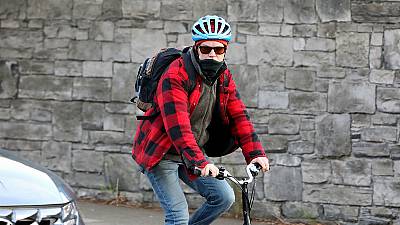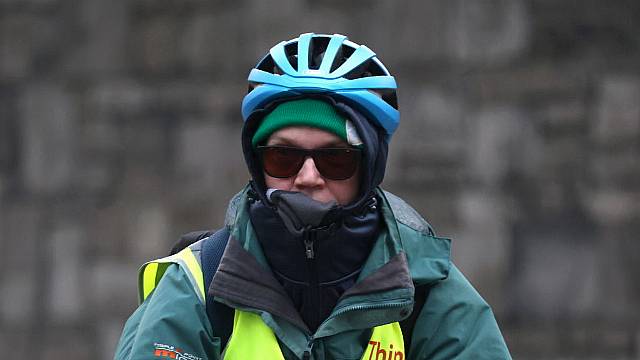Jurors in a law professor's murder trial have held and pulled the trigger of the revolver with which he fatally shot an unarmed trespasser on his farmland in the back of his head.
The prosecution invited the 12 individual members of the jury on Thursday to hold the Smith & Wesson handgun within the jury box and pull the trigger to get a sense of the 5kg of pressure required.
The judge presiding over Diarmuid Phelan's trial declined to pull the trigger of the revolver, saying: "I think I'll pass on that".
Mr Phelan (56) has pleaded not guilty to murdering father-of-four Keith Conlon (36) at Hazelgrove Farm, Kiltalown Lane, Tallaght, Dublin 24, on February 24th, 2022.
The accused man is a barrister, law lecturer and farmer who owns Hazelgrove, formerly a golf course in Tallaght.
Detective Garda Seamus O'Donnell, who is attached to the ballistics and forensics investigation section of An Garda Síochána, today told John Byrne SC, prosecuting, that he considered a defence report from Curtis Marshall, who had made observations about the heavy trigger pull of the revolver. Mr Byrne said Mr Marshall had described the double action trigger pull in his report.
"Is it consistent with 4.98kg or 11 pounds of pressure to pull the trigger? How does a heavy trigger pull feature when considering the safety of a gun?" asked Mr Byrne.
The detective said the revolver had no manually activated safety mechanism or safety switch. "Some semi-automatic pistols would have a safety switch that would trigger block. This doesn't have such a feature. You have to pull the trigger and maintain pressure. Revolvers such as this are regarded as very safe in that regard," he added.
Asked whether it was possible to discharge the weapon accidentally, the detective said he was not aware of any cases he had been involved in where that had happened. He confirmed he had 18 years experience in ballistics.
The witness agreed that, if he threw the gun on the ground having loaded it with eight rounds, it was not going to fire. Mr Byrne then told the jury he was going to invite them to hold the Smith & Wesson revolver and pull the trigger.
He told the court the weapon had been made safe but that "nobody has to do this" and that "it could be a useful exercise".
He said each juror could hold the firearm in a downward trajectory and pull the trigger to get a sense of the five kilos of pressure required. Counsel said the gun was safe and it could do "nobody any harm".
Ms Justice Siobhan Lankford declined to pull the trigger of the revolver saying: "I think I'll pass on that". Mr Byrne stressed that the exercise was not mandatory but it would give the jurors an idea of the pull pressure required.
Before a Garda presented the revolver and pairs of gloves to each member of the jury the judge said she would first like to see the officer make the firearm safe.
Mr Byrne told the judge that this had already been done but it could be done again.
Eight of the 12 jurors opted to pull the trigger of the revolver.
Mr Byrne told the members of the jury panel afterwards that if any of them wished "to engage at a later stage" then they were free to do so.
Asked about the accuracy of shooting this particular gun, the witness said as with any firearm the competency of firing and experience are huge factors. "It's a skill that some are naturally good at and others would require practice," he added.
He said modern handguns have much less trigger pressure; two to three pounds less. He agreed this is distinct from the 11 pounds of pressure needed for the revolver.
The detective said he had been furnished with information by the pathologist that Mr Conlon was 1.7 meters in height and that the wound to the back of his head was 1.64 metres in height, if the deceased had no shoes on.
"The fatal gunshot if standing straight and not wearing any shoes was 60mm below the top of the head?" asked Mr Byrne. The witness agreed.
Mr Byrne put it to the witness that having conducted a test he had come to the view that the revolver struck the target marginally low at the given range. "For me, that's how I struck the target," he replied.
"If you were to discharge the firearm one handed at an upright and 1.7m static target from a distance of five meters away and if you were to strike 6cm's below the top of the target then that means you would have to aim at a point of 18mm or 1.8cm below the top of the target?" asked Mr Byrne, to which the witness agreed.
"If you were standing at a distance of five meters away where you placed a mannequin 1.7 metres tall in order to cause the bullet to strike that individual 60mm below the top point of the head, you would have to aim at the head and 1.8cm below the top of the head?" asked counsel. The detective said this was correct.
In cross-examination, Sean Guerin SC, defending, put it to the witness that one of their experts, police psychologist Dr William Lewinski, had said in his report that the light weight of the gun and the very heavy trigger pull made the gun very safe but could cause serious problems for the control and accuracy when used at any distance.
Tests
The detective replied that, based on the tests he carried out, he would have to disagree.
It was put to the detective that people often fire revolvers with one hand and there was nothing in the Smith & Wesson safety and instruction manual which says not to do this. The detective agreed it was commonly done.
Mr Guerin also put it to the witness that a lot of people use a one handed grip and asked the witness would he not expect the manual to tell people not to do this, if they shouldn't be doing it. The witness said people do shoot with one hand but he also knows it is more accurate to fire the weapon using a two-handed grip.
"When you expressed a view about how inappropriate it is to put shot shells and bullets in the revolver, you were not aware Smith & Wesson published in their manual an image showing people you can do that?" asked counsel. "No, I wasn't," he replied.
In his direct evidence on Wednesday the detective was asked for his opinion of the practice of mixing ammunition.“I’d consider the practice of mixing different types of ammunition as extremely dangerous in this type of firearm,” Det Gda O’Donnell said. “This is two different types of ammunition with two different effects.”
Mr Guerin later suggested to the witness if it was good enough for Smith & Wesson, what was wrong with Mr Phelan mixing ammunition in his revolver.
Evidence
In her opening address, Roisin Lacey SC said the jury will hear evidence that on the day in question three men including Mr Conlon had trespassed on a wooded area of Mr Phelan's land while hunting foxes or badgers.
Ms Lacey said that Mr Phelan told gardaí he became concerned about a dog running loose on his land towards his sheep and shot it with his Winchester rifle, whereupon he said three men immediately "exploded" from the wooded area and began threatening him.
The 12 jurors were also told by the State that Mr Phelan said he was shaking with fear and "scrambled" up a bank to get away but when the deceased man Keith Conlon and a second man kept coming he believed they were "coming to fulfil the threats they had made".

As they got closer, Mr Phelan said he reached for his Smith & Wesson revolver in his pocket and fired in the air over their heads but was "stunned when one man went down", the court has heard.
Mr Conlon, from Kiltalown Park in Tallaght, was seriously injured in the shooting incident on February 22 and died at Tallaght University Hospital two days later.
The State's case, the prosecution highlighted, is that when the third shot was fired, the gun was pointed in the direction of the deceased who was shot in the back of the head when he had turned away to leave. "In those circumstances we say the accused intended to kill or cause serious injury," counsel said.
The trial continues tomorrow before Ms Justice Lankford and a jury of nine men and three women.







